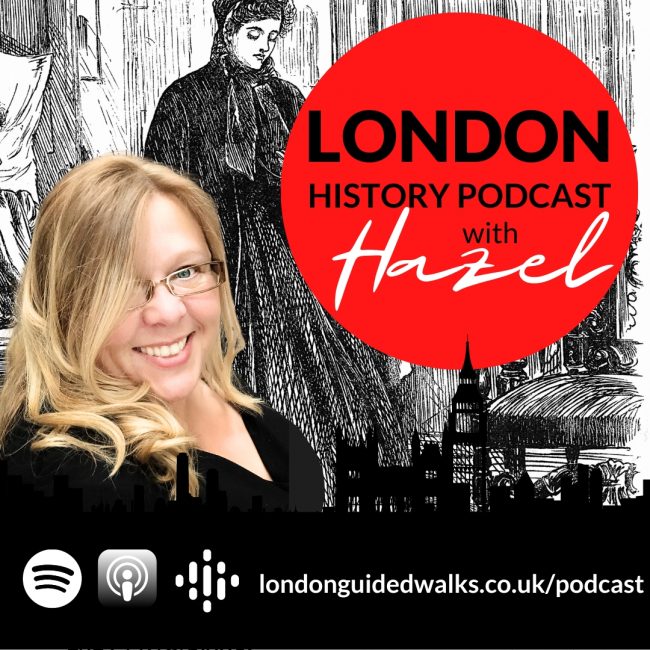Show Notes:
 Hazel Baker: Hello and welcome to London Guided Walks London History podcast. In the coming episodes, we will be sharing our love and passion for London, its people, places and history in an espresso shot with a splash of personality. For those of you who don’t know me, I am Hazel Baker, founder of London Guided Walks, providing guided walks and private tours to Londoners and visitors alike.
Hazel Baker: Hello and welcome to London Guided Walks London History podcast. In the coming episodes, we will be sharing our love and passion for London, its people, places and history in an espresso shot with a splash of personality. For those of you who don’t know me, I am Hazel Baker, founder of London Guided Walks, providing guided walks and private tours to Londoners and visitors alike.
Hazel: We’re going to look at where they were, and also the medieval view of lepers compared to our own modern sensibilities. What is it about medieval leprosy that you find so particularly interesting?
 Ian McDiarmid: One of the things that I think is interesting about leprosy and a lot of illnesses is the stigma that goes with it. It’s rather odd, isn’t it? That people who are ill should be stigmatised for that, for their suffering, but amongst the stigmatised illnesses, leprosy, I guess is pretty much towards the top of the list.
Ian McDiarmid: One of the things that I think is interesting about leprosy and a lot of illnesses is the stigma that goes with it. It’s rather odd, isn’t it? That people who are ill should be stigmatised for that, for their suffering, but amongst the stigmatised illnesses, leprosy, I guess is pretty much towards the top of the list.
Hazel: Yeah, absolutely. I mean, when I think of leprosy, I don’t really think of London at all. My mind goes to Jesus Christ superstar and the Lepers’ Song and biblical times. I don’t really think of it as coming to these shores and having so much real effect, but we’re going to be learning a little bit about that.
Ian McDiarmid: Yeah, we are. And following from what you’re saying, one of the interesting aspects of this is that there is nothing left at these London houses, but they were an important part of the urban landscape.
Hazel: Let’s get down to basics. So what is leprosy?
Ian McDiarmid: Well, it’s a disease that we now know is caused by bacteria. The bacterium was isolated in the 19th century and it won’t surprise you it’s called mycobacterium leprae and it was isolated by a man named Hansen. Talking of stigma, in clinical circles, it is no longer referred to as leprosy and is called Hansen’s disease.
Even today, it has some interesting characteristics. One is that it’s quite hard to pass on from one individual to another and the means of transmission is not necessarily particularly well understood. I don’t think it’s clear to people working in the field, why it is that certain individuals are disposed to getting it whilst others living in close proximity to them don’t.
Furthermore, when Hanson isolates it in the 1960s, sorry, the 1860s, he was doing this at a time when there was a great expansion in the use of the microscope and the great German clinician Koch said that you need to to be able to do three things to identify a disease that’s transmitted by bacteria.
One is you need to isolate the bacteria. Secondly, you need to be able to culture it, and thirdly you need to be able to inoculate people. Hansen could do the first one, but he couldn’t do the, the other two parts of it. It gives an indication of what a tricky illness it is. It’s also tricky because there are two basic kinds of the disease.
So there’s lepromatous and there is tuberculoid and tuberculoid is the less severe form. Tuberculoid leprosy basically affects only parts of the body, whereas the lepromatous disease affects all of it. So the the body’s defences in the case of the lepromatous are completely overwhelmed over a period of time.
In terms of diagnosis, they can diagnose as one of these two types, but also they can diagnose it as intermediate tuberculoid and intermediate lepromatous, and indeterminate, which indicates to me that there’s not a huge amount of clinical precision even today in identifying the disease.
It’s a disease that affects the skin. Obviously it affects the peripheral parts of the body, in particular the nerves on the peripheral parts of the body. And it can affect the, the nose and mouth especially, but also the eyes. And when it affects peripheral parts of the body people they’d lose sensation and they can get wounds, which then become infected.
And this is linked with the tendency of bones to disappear causes the deformities, due to the loss of peripheral body parts. So one of the big characteristics of the disease is it’s disfiguring effect on people. And one thing we need to bear in mind with regard to how lepers are regarded is that one symptom is fetid breath.
Hazel: So the only leper hospital that I know of in London, so I’m looking forward to learning more today, was in St. Giles.
Ian McDiarmid: There were about eight leper hospitals around London and there were three big ones and the big ones were St Giles, which which was on the site of the church of St Giles in the Fields.
The other two big ones are St James, which is easy to identify because it’s the current site of St James’s Palace, which gets its name from the earlier hospital, and which is just to the North of Westminster. And the other big one was the Lock or Les Lockes, in Southwark. This was located at the milestone to the South of London bridge. And then there’s some smaller ones as well. So there’s one at Hackney for which there are records for about 1330, but it’s probably older than that. And then there’s one at Knightsbridge and there’s one at Mile End.
These were all founded by the Corporation and there’s an obscure reference to one, a Hammersmith. And then there’s a rather interesting one at Highgate. And this is founded in the reign of Edward IV. So we’re talking in the 1470s. A member of his Yeomen Guard falls sick with leprosy, a man named William Pole and Edward grants him a piece of land to form a leper hospital.
What’s rather interesting is that this leper hospital was never for more than two or three residents. So it’s very, very small. One of the problems with our leper houses in London, but also with leprosy as a whole in England, is a lack of documentation. So it’s very difficult to reconstruct the history of it.
And it’d be very interesting to know how many lepers there were. What portion of the population suffered from leprosy? We have no idea. One of the things that I think is interesting is the small number of people that were accommodated in these hospitals. So saying that we’ve got the three big ones, of the three big ones the largest was St Giles, which was originally founded for 40 lepers.
Later on that goes through a decline, and by the 14th century that looks at that it’s down to 14, and then St. James the Less is founded for 14 nuns who were lepers. So although we’re talking about London here, they aren’t accommodating very many lepers and this might indicate that there weren’t that many lepers, but I mean, that’s not really a safe conclusion because it could well be that a lot of lepers did not enter into the hospitals,
Hazel: In my mind when you were mentioning for example Highgate, Mile End and and Hammersmith, if I was going to map that out, that basically a ring around London, aren’t they?
Ian McDiarmid: Yes, and this is of enormous importance. There’s a very, very good book ‘Leprosy in Medieval England’ by Carole Rawcliffe. And I’d like to put a link in the notes. I was going to say, I’ll put a link in the notes, but perhaps in the interest of strict accuracy, I should say I will ask you.
And one of the basic themes of this book is to challenge pre-existing concepts of the leper as being completely isolated and showing that they actually lived in a kind of inbetween world, between inclusion and exclusion. The location of these leper houses or leprosariums they were known is extremely important because they form a ring round London, as you’re saying, and they also tend to be on a main road. So St. Giles is on the main road from Oxford and from Tyburn into London, while St James is obviously near Westminster. The one in Southwark is on the main road coming in from the South of the Thames to cross London.
St Giles when it’s founded in the early 12th century was founded about a mile outside the City of London. So these are built outside the city, but close to it, and you’ll come across them as you come into the city. And there are various important reasons for this kind of building them apart, but also building them as part of the city. The reasons for exclusion are the ones that you might expect and ones which fit in with the sort of cliched view of the leper.
And these are to do primarily with exclusion because it says in the Bible that they’re not clean and that they need to be kept without the ‘camp’, but they were also worried about contagion. Their fears about contagion vary over time. So after the Black Death, people get very worried about the effects of bad air.
But even before then, they are to some extent concerned about contagion. So it makes sense to have them outside.
Then there is the inclusion. The hospitals are on the main roads. So it’s very easy for the lepers to beg. Presumably also convenience is a factor because it’s easy, relatively easy to keep them supplied with needs. But perhaps most important is that the hospitals form part of the spiritual architecture of London. As you get near to London, these are the first institutions that you come across and you will then approach the city walls, and you’ll come across just lying outside sometimes just within the city walls the large friaries and priories of London. And then you’ll get into London proper and within a city, largely built of timber, the ecclesiastical buildings stand out. You will see the parish churches, and then bang in, well, not really bang in the middle, but bang in the middle in terms of dominating a prominent Hill, is this huge, enormous church of St Paul’s And in addition to this kind of architecture of spirituality, you’ve got all the activities going on within London. So you’ve got the guilds. And we did a podcast on these when we were talking about craft guilds.
——–
Hazel: Yeah. We’ll include that in the show notes as well. Okay.
Ian McDiarmid: The craft guilds exist to promote the spiritual welfare of their members and also just promote their economic interests. But the craft guilds are only a small minority of the guild phenomenon as a whole. There are far more guilds, just dedicated to religious purposes in London.
And then in addition to that, you’ve also got this interesting phenomenon of hermits, anchorites and anchoresses. I’m sure everybody’s familiar with the idea of the hermits – they sort of live a solitary life, but they can wander around, while the anchorites and anchoresses are locked in a cell, and sometimes they are said to have been immured in a cell.
So they, they, they make the decision to become an anchorite or an anchoress and they’re sort of locked up for the rest of their lives in a single cell. And there was, for example, one anchoress in the gateway to Black Friars. And all these institutions are of enormous importance, doing religious things for the benefit of everyone. So you can go and say prayers for yourself but you’ve also got all these anchorites and anchoresses and you’ve got all these guilds, these churches and all this religious activity going on. And in particular, you’ve got all these masses being said, and this is a great benefit, not just for the individuals concerned, but for the whole community.
And I think this is the real importance of these leper houses, because the lepers, although they are regarded as being unclean, at the same time, they’re also regarded as being rather like the figure of Job suffering through bodily affliction. And they are therefore, closer to God and in a sense, spiritually clean and as a result of their sufferings, their intercessory prayers are regarded as being particularly effective.
And one thing I was saying is that the sources aren’t particularly great. So for example, at St Giles, we don’t know what kind of religious order the people that belonged to. St. James is the one house that we know that order of. The women there had to enter formally enter into a religious order in order to become cared for in the hospital.
There were 14 nuns there and there were eight Augustinian canons to look up their spiritual needs, but everywhere, when you entered into a leper hospital you had to take vows similar to those entering monastic orders: poverty, obedience chastity. And the day followed a similar regime to the monasteries, in that it was based on the canonical hours, though they had to make some adaptation because lepers come from all ranks of society. And lepers won’t necessarily be familiar with Latin. So they adapted the liturgy to have prayers in English, but it’s very important that these lepers are taking, coming under religious discipline. And it’s because, well, it’s in part because their prayers are regarded as so important by the rest of the community.
The other thing is that the people endowing these leper hospitals get great benefits because they’ve got the inmates praying for their souls afterwards. And as I said, great these have great intercessory power in terms of speeding you out of a purgatory.
Hazel: Nice get-out-of-jail-free card that, yeah. So this goes really against what we normally think about lepers.
Ian McDiarmid: Rawcliffe in her book, as I say, she’s very good at talking about this. And she says that the modern view of the leper really only develops in the 19th century, that is of the leper being somebody who’s completely excluded. She says that this comes about primarily because there’s a small resurgence of leprosy in Europe, in the 19th century, and they don’t know how to deal with it.
And one school of thought is that these lepers should be segregated in leper hospitals. And then with the physicians arguing this, the historians went back to the sources to argue that this was how things were done in medieval times, and that they had successfully contained leprosy in the Middle Ages by isolating people.
And Rawcliffe illustrates this by examples of 19th century culture. So she cites literature and some paintings of how lepers were depicted in the 19th century. And this got me thinking about horror films. So there are lots of influences on horror films, Gothic novels. I think the first world war has a huge impact, in particular on something like the Phantom of the opera.
Zombies obviously have their origin in a particular tradition, that of voodoo magic from Haiti, but they are remarkably close to the modern concept of the leper. Because whenever I’ve seen bits of zombie films the zombies are always wearing what we might properly think of lepers as wearing that sort of hooded, rather monk-like garb, which is rather greasy and with the face covered. And obviously there’s some kind of connection between zombies as the living dead and the popular view of lepers as being kind of living dead in the sense of being Isolated and shut away. And then you suggested that I watched that bit of Jesus Christ Superstar, which is, forgive me if I’m quoting it wrong, the Leper Song. I watched that and there the connection is made absolutely expressly because these lepers are absolute zombies. They crowd round the figure of Jesus in a sort of frightening clawing way.
And then there’s one bit when one of the lepers crawls out of a hole, then rushes back in again, I mean, he’s just like a zombie. So yeah, the modern view of them is not very sympathetic.
Hazel: Thank you so much. And once again you are a font of all knowledge and wow! I mean, leprosy and zombies who knew they went together?.
I will not be able to watch Michael Jackson’s Thriller in the same light ever again.
Ian McDiarmid: Yeah, I forgot all about him. Thank you for reminding me.


 Hazel Baker:
Hazel Baker:  Ian McDiarmid:
Ian McDiarmid: 









